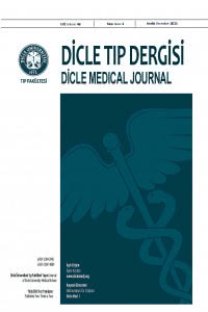The Differences Between Cases With Primary and Recurrent Shoulder Dislocation: A Tertiary Center Study
The Differences Between Cases With Primary and Recurrent Shoulder Dislocation: A Tertiary Center Study
Shoulder dislocation; primary; recurrent; demographic, Shoulder dislocation; primary;, recurrent;, demographic,
___
- 1. Owens BD, Duffey ML, Nelson BJ, et al. The incidence and characteristics of shoulder instability at the United States Military Academy. Am J Sports Med. 2007; 35:1168-73.
- 2. Lippit S, Matsen F.A. Mechanisms of glenohumeral joint instability. Clin Orthop. 1993; 291: 20-8.
- 3. Kazar B, Relovszky E. Prognosis of primary dislocation of the shoulder. Acta Orthop Scand. 1969; 40: 216-24.
- 4. Rowe C.R. Prognosis in dislocations of the shoulder. J Bone Joint Surg Am. 1956; 38: 957-77.
- 5. Yalaman O. Reduksiyonu gecikmiş travmatik omuz çıkıklarında tedavi sonuçları. İstanbul Tıp Fakültesi. Tez – 1979.
- 6. Hawkins R.J, Neer C.S, Pianta RM, et al. Locked posterior dislocation of the shoulder. J Bone Joint Surg Am. 1987; 69: 9-18.
- 7. Itoi E, Hatakeyama Y, Kido T, et al. A new method of immobilization after traumatic anterior dislocation of the shoulder: a preliminary study. J Shoulder Elbow Surg. 2003; 12: 413-5.
- 8. Arciero RA, Wheeler JH, Ryan JB, et al. Arthroscopic Bankart repair versus nonoperative treatment for acute, initial anterior shoulder dislocations. Am J Sports Med. 1994; 22: 589-94.
- 9. Hawkins RJ, Abrams JS. Impingement Syndrome in the Absence of Rotator Cuff Tear (Stage 1 and 2). Orthop. Clin.North.Am. 1987; 18: 373-82.
- 10. Te Slaa RL, Wijffels MP, Brand R, et al. The prognosis following acute primary glenohumeral dislocation. J Bone Joint Surg Br. 2004; 86: 58-64.
- 11. Kim DS, Yoon YS, Yi CH. Prevalence Comparison of Accompanying Lesions Between Primary and Recurrent Anterior Dislocation in the Shoulder. Am J Sports Med. 2010; 38(10): 2071-6.
- 12. Taş M, Canbora K, Köse O, et al. Türkiye'nin bir şehrindeki travmatik omuz çıkıklarının demografik ve klinik özellikleri:208 olgunun geriye dönük analizi. Acta Orthop Traumatol Turc. 2013; 47: 147- 52.
- 13. Zacchilli MA, Owens BD. Epidemiology of shoulder dislocations presenting to emergency departments in the United States. J Bone Joint Surg Am. 2010; 92: 542-9.
- 14. Handoll H.H.G, Al-Maiyah M.A. Surgical versus non‐surgical treatment for acute anterior shoulder dislocation. Cochrane Database of Systematic Review. Version published: 26 January 2004.
- 15. Krøner K, Lind T, Jensen J. The epidemiology of shoulder dislocations. Arch Orthop Trauma Surg. 1989; 108: 288-90.
- 16. Özden R, U ruç V , D uman İ , e t a l. A kut akromioklaviküler eklem çıkıklarında endobutton ile tesbit yöntemi. Dicle Tıp Dergisi. 2014; 41: 268- 71.
- ISSN: 1300-2945
- Yayın Aralığı: 4
- Başlangıç: 1963
- Yayıncı: Cahfer GÜLOĞLU
A Rare Cause of Piyogenic Liver Abscess: Gemella morbillorum
Hatice Hale GÜMÜS, Ebru ORUC, Hikmet Eda ALISKAN, Yusuf Ziya DEMİROGLU, İlker ÖDEMİS, Zafer KOC
Gülce Naz YAZICI, Seren Gülşen GÜRGEN, Mukadder SUNAR, Ali CANSU
Selin KOÇ, Engin RAMAZANOĞLU, Burcu TALU
Effects of Rhodiola rosea on indomethacin-induced gastric injury
Irmak Ferah OKKAY, Ufuk OKKAY, Ozhan KARATAS
Venomous Snakebites in Children in Southeast Turkey
Arzu OTO, Yusuf Kenan HASPOLAT
The Association Between Weight Loss and Platelet Markers in Morbidly Obese Patients
Gamze ÖZTÜRK, Müzeyyen ASLANER AK, Sehmus ERTOP
Gülcan BULUT, Harika ATMACA, Burçak KARACA
Seyhmus KÜLAHCİOGLU, Murat KARACAM, Nesri DANISMAN, Seref Berk TUNCER, Barkın KÜLTÜRSAY, Ali Furkan TEKATLİ, Ayhan TOSUN, Ravza Betül AKBAS, Ayhan KÜP, Mehmet AYTÜRK, Ender Özgün ÇAKMAK, Abdülkadir USLU
Investigation of Dentists' Opinions on Pharmacovigilance and Reporting of Adverse Effects
